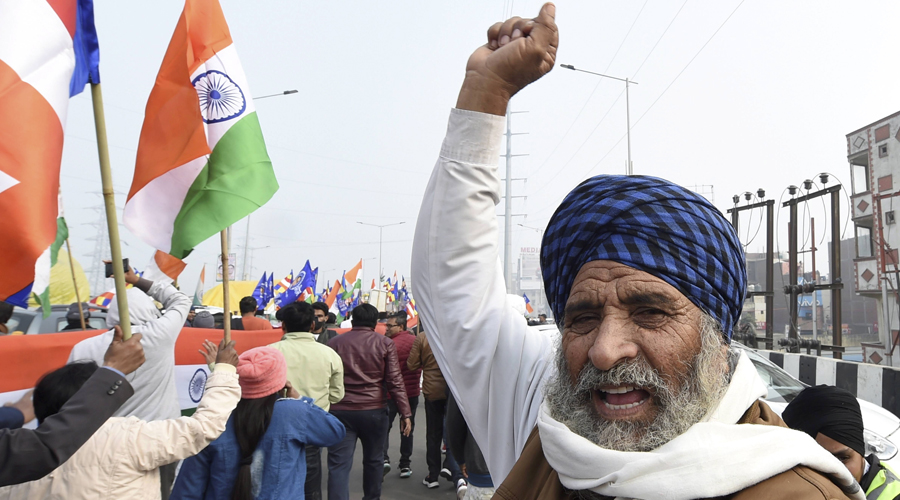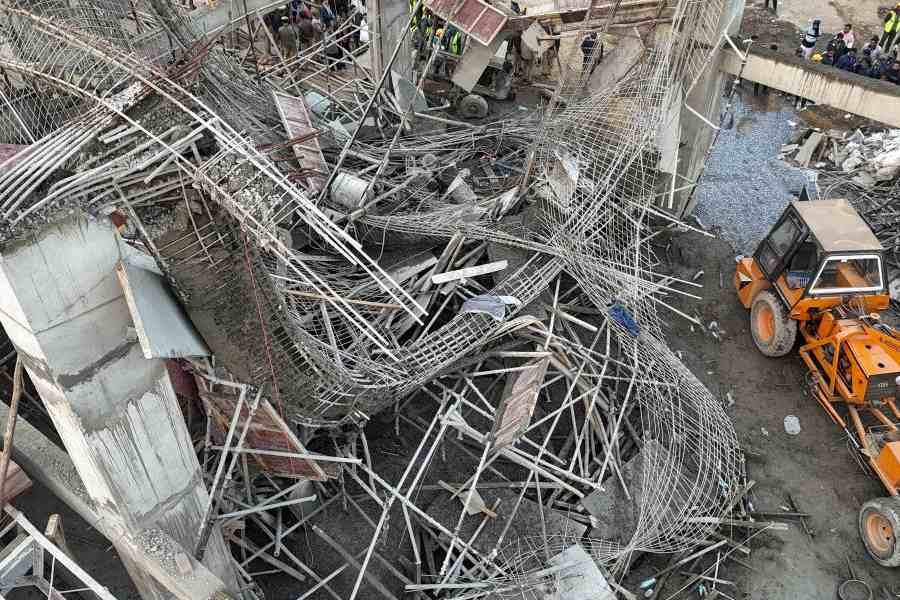What happened in Delhi on Republic Day was almost an inevitability, brewing not least because of the Centre’s dismissive response to what has come to be known as the farmers’ movement.
The business of apportioning responsibility can come later. First, however, we have to focus on a critical element of what’s been going on – the almost universal representation of the agitation as a ‘farmers’ movement’. Once we’ve unpacked that misleading description, we have to focus on, second, what the impugned farm laws are all about. And, finally, we have to see how these laws could affect different sorts of ‘farmers’.
First off, ‘farmer’ is a catch-all category; it could be substituted by ‘agriculturist’, which is also a meaningless category because it fails to make critical distinctions. In other words, anyone who ‘farms’ – which is itself a concept open to disputation – is a farmer.
‘Peasant’ is the category more usually associated with studies of agrarian society. And agrarian, or peasant, society is deeply stratified. Let’s do a 101. If we stick to four categories – large peasant, middle peasant, small and marginal peasant, and landless labourers – we will have covered peasant society.
The classification of peasants in terms of landholding varies – for instance, according to the government’s criteria a large ‘farmer’ is one who has over 10 hectares (ha) of land; a middle peasant 4-10 ha; a semi-medium peasant 2-4 ha; a small peasant 1-2 ha; and a marginal peasant below 1 ha (https://pib.gov.in/newsite/PrintRelease.aspx?relid=188051). One hectare equals about 2.5 acres. Since this classification could vary, the important thing is the functional roles of peasant classes in the agrarian economy.
The rule of thumb is that large peasants sell a preponderant portion of the grain they grow – that is, they cultivate for the market. Medium and semi-medium peasants also cultivate for the market, selling most of whatever grains they grow. Obviously, proportions are inflected by landholding size – 2-10 ha (around 5-25 acres) constitutes a pretty wide spectrum. Small peasants cultivate for subsistence, often having to supplement even their grain requirements, which is almost universally true for marginal peasants. The supplementary work undertaken to make ends meet differs widely, including through migration.
The point now is how the three contentious farm laws affect different peasant classes. We are dealing with the three laws that are primarily contentious.
The three laws passed last year were the Farmers’ Produce Trade and Commerce (Promotion and Facilitation) Act; the Farmers (Empowerment and Protection) Agreement on Price Assurance and Farm Services Act; and the Essential Commodities (Amendment) Act.
The first piece of legislation effectively abolishes the monopoly of trading in mandis regulated by the Agricultural Produce Market Committees (APMCs), thus allowing for trade in agricultural produce in general anywhere, without being regulated by APMCs or other authorities. Any entity can engage in trade both within a state and between states.
The second establishes legal conditions for contract farming, which involves a cultivator entering into a pre-cultivation agreement with a given entity specifying crops to be grown, prices, etc.
The third significantly decontrols the magnitude of stocks of, among other things, agricultural commodities that can be held by an entity, by diluting the conditions under which the government can regulate stockpiling.
Before we get to the three laws and the opposition to them, we must take note of another significant, non-negotiable condition stipulated by the Samyukt Kisan Morcha, the apex body of farm unions, which is fronting the movement. This condition, unconnected to the primary demand for the repeal of the laws, is for legislation to mandate procurement of agricultural produce at a minimum support price (MSP).
As of now, there is no statutory guarantee for procurement at a given MSP. If a legal guarantee is provided, there are two options: either, the government would have to buy the entire marketable surplus of the 23 crops currently on the MSP list; or, it would have to force private traders to buy at the minimum guaranteed price as well. The former is obviously the more feasible proposition though it would entail an increased financial commitment. There is also a dispute over the formula for calculating MSP, with peasant unions agitating for the implementation of the formula proposed in the M.S. Swaminathan reports and the government fudging. Without going into those somewhat complex details, it is obvious that MSP is more important to farmers who grow huge marketable surpluses than small and marginal farmers who consume most of their produce, especially given that MSP covers seven cereals, five pulses, seven oilseeds and four commercial crops, rather than, say, vegetables, which small farmers sell in the market.
It is no surprise, therefore, that the ‘farmers’ movement’ is being spearheaded by presumably rich peasants from Punjab, Haryana and western Uttar Pradesh, the laboratories of the Green Revolution of the late 1960s, who grow huge marketable surpluses, rather than those from, say, West Bengal, Bihar or Odisha, who don’t.
Does this mean that this movement is, as some apologists of the farm laws have argued, essentially a rich peasant affair and that in reality semi-medium, small and marginal peasants are not participating in the stir because they will gain rather than lose if these laws are implemented? The simple answer is: No.
Let’s get back to the three laws. What the agitators are saying, reduced to its basics, is that they are designed to facilitate the takeover of the agricultural sector by the corporate sector. The amendment to existing legislation on regulating stocks of essential commodities is the weakest link. In a country where hoarding and price-fixing already shafts producers and consumers alike, without big players being significantly involved, the suspect nature of this amendment is a no-brainer.
As for allowing unregulated trade, it’s hardly a stretch to imagine that once corporates get into the game, a lot of small traders and merchants are going to get elbowed out. It’s not as if today’s middlemen don’t exploit farmers and consumers, but the establishment of monopolistic conditions, economic logic assures us, will make matters worse. The smaller the participant in the market, the worse will be his or her plight. The large peasants’ fears will apply more massively to semi-middle, small and marginal farmers. Deregulation in Bihar, implemented by Chief Minister Nitish Kumar in 2006, has been disastrous for peasants.
It is sometimes assumed that contract farming is necessarily beneficial to peasants with small holdings because it assures them the necessary inputs and guarantees a market. Where big corporate entities are involved, this hasn’t been the case. Small peasants have very little bargaining power against those whom they contract with (or will). Once tied to particular arrangements, with regard to crops to be grown, input sources and supplies, and other details, whatever wiggle room they have, will go. This has been the experience throughout the developing world where contract farming exists on a significant scale – Mexico, Nigeria, Thailand and India for example. In best-case scenarios, it has been a mixed blessing.
Between them, the laws relating to trade and contract farming could cause de-peasantization on a significant scale – that is, the conversion of small and marginal peasants to landless labourers because of the loss of their land.
Which is why what happened on 26 January was not a surprise. The government has been stringing the agitators on for a couple of months. Over a hundred agitators have died of various health-related causes, sitting around in the biting north Indian winter, rendered worse by a longer-than-usual spell of wet weather.
Is it a stretch to imagine that those with more to lose in the sense that they have less to cling to will go on the offensive?
(Suhit K. Sen is a freelance journalist and an independent historian)











